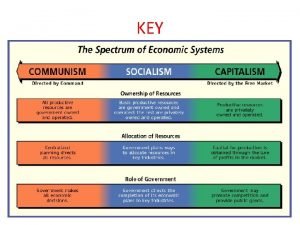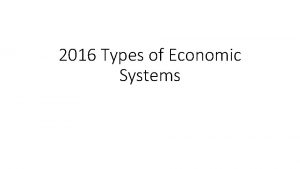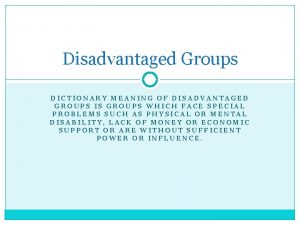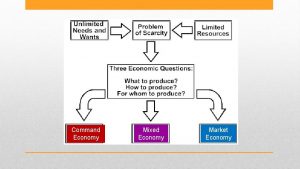How the mixed economy of childcare affects disadvantaged









- Slides: 9

How the mixed economy of childcare affects disadvantaged children Ivana La Valle Co-director of the Families and Children Research Group

Overview of the presentation • Early years education (EYE) and childcare: what has been achieved in the past decade? • What remains to be done? • Can Local Authorities do it?

EYE for 3 and 4 year olds: what has been achieved? • Take-up almost universal among 4 year olds (97%) and very high among 3 year olds (90%) • Participation has increased across all groups, including children who have traditionally been underpresented in EYE (e. g. from lone parent and low income families, with SEN) Key features of EYE strategy: • EYE universally available • EYE free at the point of use • Large proportion of EYE delivered by state sector • Implicit message: EYE is a public responsibility

EYE for 3 and 4 year olds: what remains to be done? • A small minority do not attend EY settings: • • children with SEN (13%) non-working families (11%) lone parents (10%) low income groups (9%) • Parental preferences play a part, but so do barriers: • can’t afford EYE (14%) • local settings do not cater for child’s age (16%) • all settings full/no EYE locally (14%)

EYE for 3 and 4 year olds: what next? • Better information and outreach strategies - could the 2 year old pilots provide useful lessons? • Need to ensure the free entitlement is genuinely free: inform parents and monitor settings • Is the level of funding for the free entitlement adequate?

Childcare: what has been achieved? • • Increase from 14% to 18% of 2 year olds in day nurseries Little change in 3 -4 year olds in day nurseries No significant change in use of childminders ASCs increased from 8% to 16% among 5 -11 year olds, from 2% to 6% among 12 -14 year olds • Disadvantaged children considerably less likely to attend these settings Key features of the childcare strategy: • Regulated by market forces - with government intervention to redress market imbalances • Partly funded with subsidies targeted mainly at disadvantaged groups • Mix of supply and demand side funding

Childcare: what remains to be done? • Overall little change in maternal employment, but increase in long PT hours and lone parents in work • Childcare barriers to work have declined, but significant minority not working because can’t find/afford childcare, particularly lone mothers and low income families • Still a gap for services at atypical hours, holiday care, flexible/part-time provision and for disabled children • Cost remains a barrier particularly for disadvantaged groups, funding system very complex • Mothers of disadvantaged children considerably less likely to have access to family-friendly arrangements

Childcare: what LAs need to do • Gather very sophisticated ‘market intelligence’ on many different childcare markets and understand barriers v. parents’ and children’s preferences • Persuade settings to provide non-profitable or even loss making services e. g. atypical hours, flexible, requiring high level of support, free/low cost provision • Increase childcare quality but ensure this does not lead to higher fees

Childcare: how can LAs do it? • LAs have a duty to ensure adequate and affordable provision is available, including for disabled and SEN children • Sustained political commitment and growing expertise in childcare management at the local and national level • LAs have control over funding but not all of it, and overall funding level insufficient • Unequal access to family-friendly arrangements very limited role for LAs

















